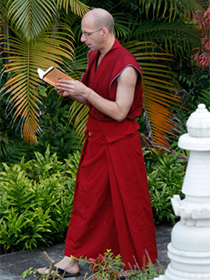- Home
- FPMT Homepage
Foundation for the Preservation of the Mahayana Tradition
The FPMT is an organization devoted to preserving and spreading Mahayana Buddhism worldwide by creating opportunities to listen, reflect, meditate, practice and actualize the unmistaken teachings of the Buddha and based on that experience spreading the Dharma to sentient beings. We provide integrated education through which people’s minds and hearts can be transformed into their highest potential for the benefit of others, inspired by an attitude of universal responsibility and service. We are committed to creating harmonious environments and helping all beings develop their full potential of infinite wisdom and compassion. Our organization is based on the Buddhist tradition of Lama Tsongkhapa of Tibet as taught to us by our founders Lama Thubten Yeshe and Lama Thubten Zopa Rinpoche.
- Willkommen
Die Stiftung zur Erhaltung der Mahayana Tradition (FPMT) ist eine Organisation, die sich weltweit für die Erhaltung und Verbreitung des Mahayana-Buddhismus einsetzt, indem sie Möglichkeiten schafft, den makellosen Lehren des Buddha zuzuhören, über sie zur reflektieren und zu meditieren und auf der Grundlage dieser Erfahrung das Dharma unter den Lebewesen zu verbreiten.
Wir bieten integrierte Schulungswege an, durch denen der Geist und das Herz der Menschen in ihr höchstes Potential verwandelt werden zum Wohl der anderen – inspiriert durch eine Haltung der universellen Verantwortung und dem Wunsch zu dienen. Wir haben uns verpflichtet, harmonische Umgebungen zu schaffen und allen Wesen zu helfen, ihr volles Potenzial unendlicher Weisheit und grenzenlosen Mitgefühls zu verwirklichen.
Unsere Organisation basiert auf der buddhistischen Tradition von Lama Tsongkhapa von Tibet, so wie sie uns von unseren Gründern Lama Thubten Yeshe und Lama Thubten Zopa Rinpoche gelehrt wird.
- Bienvenidos
La Fundación para la preservación de la tradición Mahayana (FPMT) es una organización que se dedica a preservar y difundir el budismo Mahayana en todo el mundo, creando oportunidades para escuchar, reflexionar, meditar, practicar y actualizar las enseñanzas inconfundibles de Buda y en base a esa experiencia difundir el Dharma a los seres.
Proporcionamos una educación integrada a través de la cual las mentes y los corazones de las personas se pueden transformar en su mayor potencial para el beneficio de los demás, inspirados por una actitud de responsabilidad y servicio universales. Estamos comprometidos a crear ambientes armoniosos y ayudar a todos los seres a desarrollar todo su potencial de infinita sabiduría y compasión.
Nuestra organización se basa en la tradición budista de Lama Tsongkhapa del Tíbet como nos lo enseñaron nuestros fundadores Lama Thubten Yeshe y Lama Zopa Rinpoche.
A continuación puede ver una lista de los centros y sus páginas web en su lengua preferida.
- Bienvenue
L’organisation de la FPMT a pour vocation la préservation et la diffusion du bouddhisme du mahayana dans le monde entier. Elle offre l’opportunité d’écouter, de réfléchir, de méditer, de pratiquer et de réaliser les enseignements excellents du Bouddha, pour ensuite transmettre le Dharma à tous les êtres. Nous proposons une formation intégrée grâce à laquelle le cœur et l’esprit de chacun peuvent accomplir leur potentiel le plus élevé pour le bien d’autrui, inspirés par le sens du service et une responsabilité universelle. Nous nous engageons à créer un environnement harmonieux et à aider tous les êtres à épanouir leur potentiel illimité de compassion et de sagesse. Notre organisation s’appuie sur la tradition guéloukpa de Lama Tsongkhapa du Tibet, telle qu’elle a été enseignée par nos fondateurs Lama Thoubtèn Yéshé et Lama Zopa Rinpoché.
Visitez le site de notre Editions Mahayana pour les traductions, conseils et nouvelles du Bureau international en français.
Voici une liste de centres et de leurs sites dans votre langue préférée
- Benvenuto
L’FPMT è un organizzazione il cui scopo è preservare e diffondere il Buddhismo Mahayana nel mondo, creando occasioni di ascolto, riflessione, meditazione e pratica dei perfetti insegnamenti del Buddha, al fine di attualizzare e diffondere il Dharma fra tutti gli esseri senzienti.
Offriamo un’educazione integrata, che può trasformare la mente e i cuori delle persone nel loro massimo potenziale, per il beneficio di tutti gli esseri, ispirati da un’attitudine di responsabilità universale e di servizio.
Il nostro obiettivo è quello di creare contesti armoniosi e aiutare tutti gli esseri a sviluppare in modo completo le proprie potenzialità di infinita saggezza e compassione.
La nostra organizzazione si basa sulla tradizione buddhista di Lama Tsongkhapa del Tibet, così come ci è stata insegnata dai nostri fondatori Lama Thubten Yeshe e Lama Zopa Rinpoche.
Di seguito potete trovare un elenco dei centri e dei loro siti nella lingua da voi prescelta.
- 欢迎 / 歡迎
简体中文
“护持大乘法脉基金会”( 英文简称:FPMT。全名:Foundation for the Preservation of the Mahayana Tradition) 是一个致力于护持和弘扬大乘佛法的国际佛教组织。我们提供听闻,思维,禅修,修行和实证佛陀无误教法的机会,以便让一切众生都能够享受佛法的指引和滋润。
我们全力创造和谐融洽的环境, 为人们提供解行并重的完整佛法教育,以便启发内在的环宇悲心及责任心,并开发内心所蕴藏的巨大潜能 — 无限的智慧与悲心 — 以便利益和服务一切有情。
FPMT的创办人是图腾耶喜喇嘛和喇嘛梭巴仁波切。我们所修习的是由两位上师所教导的,西藏喀巴大师的佛法传承。
繁體中文
護持大乘法脈基金會”( 英文簡稱:FPMT。全名:Found
ation for the Preservation of the Mahayana Tradition ) 是一個致力於護持和弘揚大乘佛法的國際佛教組織。我們提供聽聞, 思維,禪修,修行和實證佛陀無誤教法的機會,以便讓一切眾生都能 夠享受佛法的指引和滋潤。 我們全力創造和諧融洽的環境,
為人們提供解行並重的完整佛法教育,以便啟發內在的環宇悲心及責 任心,並開發內心所蘊藏的巨大潛能 — 無限的智慧與悲心 – – 以便利益和服務一切有情。 FPMT的創辦人是圖騰耶喜喇嘛和喇嘛梭巴仁波切。
我們所修習的是由兩位上師所教導的,西藏喀巴大師的佛法傳承。 察看道场信息:
- FPMT Homepage
- News/Media
-
- Study & Practice
-
-
- About FPMT Education Services
- Latest News
- Programs
- New to Buddhism?
- Buddhist Mind Science: Activating Your Potential
- Heart Advice for Death and Dying
- Discovering Buddhism
- Living in the Path
- Exploring Buddhism
- FPMT Basic Program
- FPMT Masters Program
- FPMT In-Depth Meditation Training
- Maitripa College
- Lotsawa Rinchen Zangpo Translator Program
- Universal Education for Compassion & Wisdom
- Online Learning Center
-
- Prayers & Practice Materials
- Overview of Prayers & Practices
- Full Catalogue of Prayers & Practice Materials
- Explore Popular Topics
- Benefiting Animals
- Chenrezig Resources
- Death & Dying Resources
- Lama Chopa (Guru Puja)
- Lama Zopa Rinpoche: Compendium of Precious Instructions
- Lama Zopa Rinpoche: Life Practice Advice
- Lama Zopa Rinpoche Practice Series
- Lamrim Resources
- Mantras
- Prayer Book Updates
- Purification Practices
- Sutras
- Thought Transformation (Lojong)
- Audio Materials
- Dharma Dates - Tibetan Calendar
- Translation Services
- Publishing Services
- Ways to Offer Support
- Prayers & Practice Materials
-
- Teachings and Advice
- Find Teachings and Advice
- Lama Zopa Rinpoche Advice Page
- Lama Zopa Rinpoche: Compendium of Precious Instructions
- Lama Zopa Rinpoche Video Teachings
- ༧སྐྱབས་རྗེ་བཟོད་པ་རིན་པོ་ཆེ་མཆོག་ནས་སྩལ་བའི་བཀའ་སློབ་བརྙན་འཕྲིན།
- Podcasts
- Lama Yeshe Wisdom Archive
- Buddhism FAQ
- Dharma for Young People
- Resources on Holy Objects
- Teachings and Advice
-
-
*If a menu item has a submenu clicking once will expand the menu clicking twice will open the page.
-
-
- Centers
-
- Teachers
-
- Projects
-
-
-
-
*If a menu item has a submenu clicking once will expand the menu clicking twice will open the page.
-
-
- FPMT
-
-
-
-
-
Right understanding is the only solution to both physical and mental problems. You should always check very carefully how you’re expending your energy: will it make you happy or not? That’s a big responsibility, don’t you think? It’s your choice: the path of wisdom or the path of ignorance.
Lama Thubten Yeshe
-
-
-
- Shop
-
-
-
The Foundation Store is FPMT’s online shop and features a vast selection of Buddhist study and practice materials written or recommended by our lineage gurus. These items include homestudy programs, prayers and practices in PDF or eBook format, materials for children, and other resources to support practitioners.
Items displayed in the shop are made available for Dharma practice and educational purposes, and never for the purpose of profiting from their sale. Please read FPMT Foundation Store Policy Regarding Dharma Items for more information.
-
-
FPMT News Around the World
20
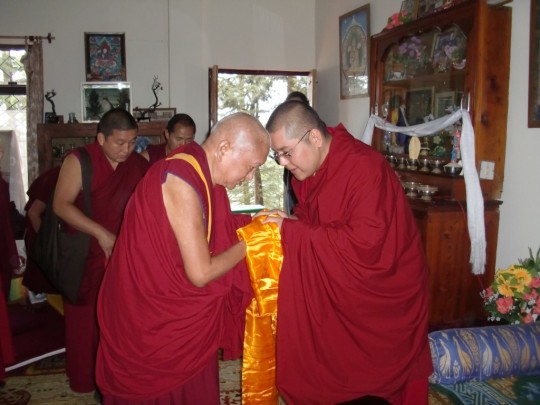
Lama Zopa Rinpoche greets is His Eminence Ling Rinpoche, Tushita Meditation Centre, Dharamsala, India, March 2015. Photo courtesy of Tushita Meditation Centre.
Spiritual program coordinator Ven. Tenzin Kunphen shared a very brief summary of all that Tushita Meditation Centre in Dharamsala, India has accomplished over the first half of the 2015 season:
Tushita’s latest news is out and there is much to rejoice in!
During the first half of our 2015 season we have not only hosted nine introductory, two intermediate, and one advanced courses; one pre-ordination course; and three tantric retreats; but also hosted our precious guru Lama Zopa Rinpoche twice, in addition to His Eminence Ling Rinpoche, Jhado Rinpoche, Dagri Rinpoche (twice), Khadro-la (Rangjung Neljorma Khadro Namsel Drönme), Jetsünma Tenzin Palmo, Tenzin Ösel Hita and Gen Gyatso.
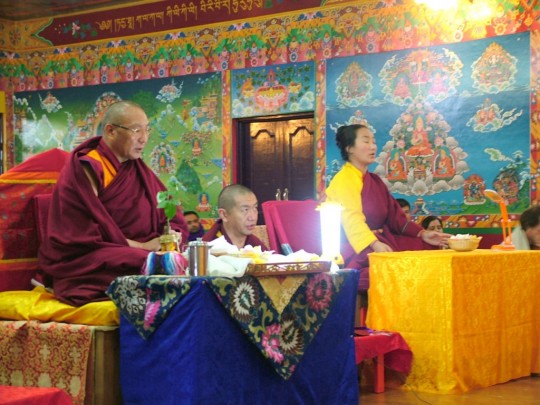
Dagri Rinpoche and Khadro-la consecrating new statues, Tushita Meditation Centre, Dharamsala, India, February 2015. Photo courtesy of Tushita Meditation Centre.
We also completed construction on three beautiful retreat huts, two new stupas, and consecrated our new statues.
There was so much news that we organized it all on our website for interested students: http://tushita.info/news/the-first-half-of-our-season-much-reason-to-rejoice/
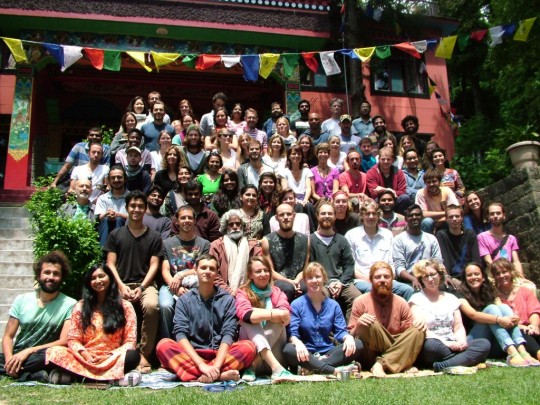
Introduction to Buddhism Course with Shahar Tene, Tushita Meditation Centre, Dharamsala, India, May 2015. Photo courtesy of Tushita Meditation Centre.
Mandala brings you news of Lama Zopa Rinpoche and of activities, teachings and events from over 160 FPMT centers, projects and services around the globe. If you like what you read on Mandala, consider becoming a Friend of FPMT, which supports our work.
- Tagged: tushita meditation centre
- 0
17
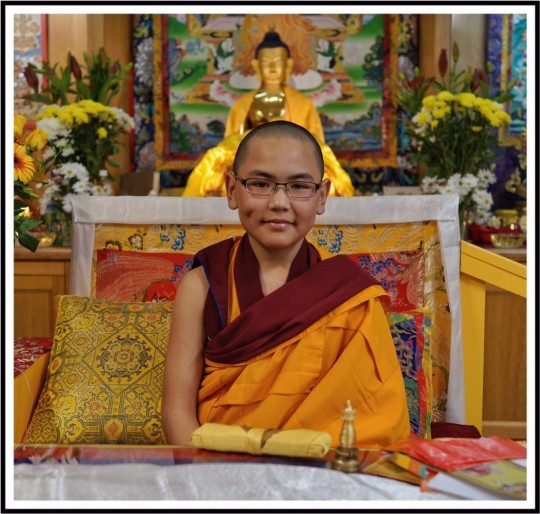
Tenzin Phuntsok Rinpoche, Hayagriva Buddhist Centre, Perth, Australia, August 2015. Image courtesy of Hayagriva Buddhist Centre.
Long-time student Owen Cole shares exciting news about Tenzin Phuntsok Rinpoche’s recent visit to Hayagriva Buddhist Centre in Perth, Australia:
Tenzin Phuntsok Rinpoche, the diminutive 12-year-old reincarnation of the great yogi and meditator Geshe Lama Konchog, has been secretly attending school for the last three-and-a-half years in Perth.
He ended the seclusion by attending a blessing at Perth’s Hayagriva Buddhist Centre on August 10. Accompanied by his attendant in this and the past life, Geshe Tenzin Zopa, he was welcomed by the resident teacher, Geshe Sonam, Ven. Robina Courtin and more than 90 students.
Geshe Zopa explained they had kept their presence in Perth quiet as Phuntsok Rinpoche couldn’t say no to the many visitors he had while in Kopan Monastery, which interfered with his studies.
Geshe-la said he decided Rinpoche should receive a Western education, a decision opposed by many but which came with the blessing of their guru, Lama Zopa Rinpoche. Geshe-la also said that the move had been planned with the late former Abbot of Kopan Monastery, Khensur Rinpoche Lama Lhundrup.
Perth was chosen because of a friend in the city. They lived in the suburb next to Hayagriva Buddhist Centre throughout their stay.
Geshe Zopa said they passed the center often and it broke his heart that they couldn’t go in, but he knew it would interfere with Rinpoche’s education if word got out that they were in Australia. Rinpoche attended a private school in lay clothes and Geshe-la picked him up from school similarly dressed. The school had no idea they were monks.
During their stay, Geshe Zopa did Yamantaka retreat in the suburban house in which they stayed. He said this showed you don’t need a cave in Nepal to do a retreat!
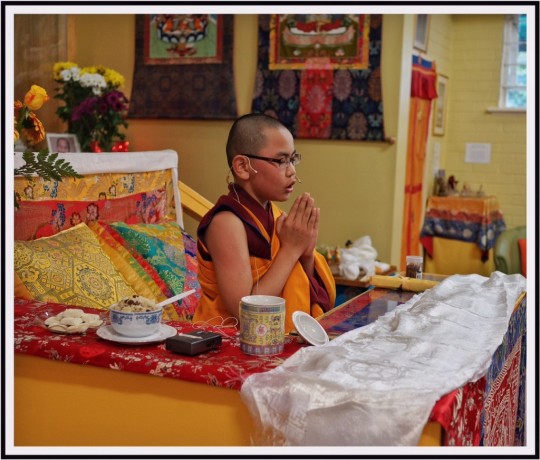
Tenzin Phuntsok Rinpoche, Hayagriva Buddhist Centre, Perth, Australia, August 2015. Image courtesy of Hayagriva Buddhist Centre.
Speaking fluent English, Phuntsok Rinpoche told Hayagriva students that his favorite subjects at school were maths and philosophy. He is also highly interested in science. Geshe-la said many lamas, including His Holiness the Dalai Lama, emphasize the importance of understanding science to understand the culture to teach the Dharma in the West.
Geshe Zopa said high lamas now spend more time teaching in the West than in India or Nepal as Buddhism is becoming more established there and that it will take root in the West as it did in Tibet.
Phuntsok Rinpoche’s time in Perth has ended and next month he will start studying in India’s Sera Je Monastery where his attendant will be Geshe Zopa’s brother, who also served Geshe Lama Konchog.
During his visit to Hayagriva, Rinpoche had total control of the event. He led the prayers and gave transmissions of the mantras of Hayagriva (a practice of Geshe Lama Konchog), Chenrezig and Manjushri. This followed the offering of the body, speech and mind mandala and the traditional offering of sweet tea and rice which was given to Rinpoche and all the guests.
Answers to questions from students were short and precise, in the best Geshe Lama Konchog tradition, showing a wisdom and maturity way beyond what could be expected of a 12-year-old. Topics ranged from how to develop a good heart in the young to overcoming fear, dealing with the environment and preparing for death. For one student who wanted to know about her past and future, “Just focus on the present,” was his reply.
Rinpoche and Geshe Zopa visited the Hospice of Mother Tara in Bunbury last weekend and will visit other Australian FPMT centers in coming weeks.
A lightly edited 15-minute video of Phuntsok Rinpoche’s session at Hayagriva Buddhist Centre is now on YouTube:
https://www.youtube.com/watch?v=jjEYe6CZbQk
Mandala brings you news of Lama Zopa Rinpoche and of activities, teachings and events from over 160 FPMT centers, projects and services around the globe. If you like what you read on Mandala, consider becoming a Friend of FPMT, which supports our work.
- Tagged: owen cole, tenzin phuntsok rinpoche
- 1
13
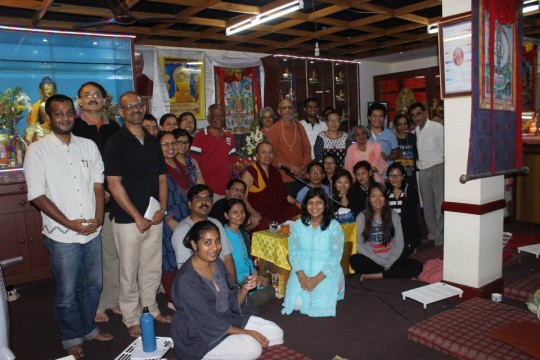
Choe Khor Sum Ling students with Geshe Dorji Damdul, Bangalore, India, July 2015. Photo courtesy of Choe Khor Sum Ling.
Student Deepthy Shekhar from FPMT center Choe Khor Sum Ling in Bangalore, India, shared with Mandala their recent news:
Choe Khor Sum Ling (CKSL) celebrated His Holiness the Dalai Lama’s 80th birthday on July 6, 2015 with an extensive Guru Puja with extensive offerings and prayers and practices for the long life of His Holiness. This was led by Gen. Tenzin Namjong who also released a book complied by CKSL to commemorate His Holiness’ birthday. This book contained various prayers and practices composed by His Holiness and Lama Zopa Rinpoche, and even His Holiness’ Nobel Peace Prize acceptance speech.
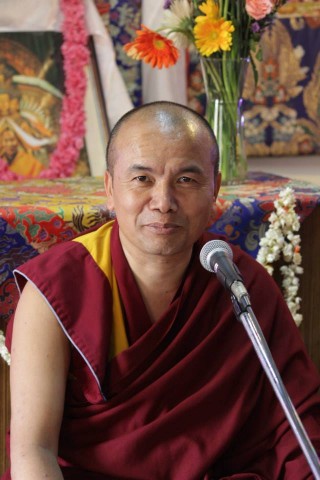
Geshe Dorji Damdul. Photo courtesy of Choe Khor Sum Ling.
Starting on July 10, CKSL hosted teachings by Geshe Dorji Damdul, who visited from Tibet House in Delhi and gave a seven-day teaching, which included two long days of teachings on the topics of dependent origination, the four mindfulnesses, meditations to establish emptiness on the four essentials, bodhichitta and meditations on Mahamudra. These teachings brought forth many students to the center, who had many questions to ask. These teachings were engaging, illuminating and inspiring. Students requested Geshe Dorji Damdul to visit the center again.
Mandala brings you news of Lama Zopa Rinpoche and of activities, teachings and events from nearly 160 FPMT centers, projects and services around the globe. If you like what you read on Mandala, consider becoming a Friend of FPMT, which supports our work.
10
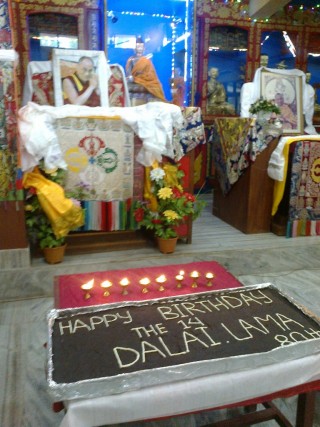
Cake in celebration of His Holiness the Dalai Lama’s 80th birthday, Root Institute, Bodhgaya, India, July 2015. Photo courtesy of Root Institute.
Spiritual program coordinator Ven. Lozang Khadro from Root Institute in Bodhgaya, India shared with Mandala how the center celebrated His Holiness the Dalai Lama’s 80th birthday and recent staff changes:
The celebrations for His Holiness the 14th Dalai Lama’s 80th birthday in July began with a recitation of his long life prayer in Hindi in our main gompa, followed by offerings of khatas by the staff and volunteers. A beautifully decorated birthday cake along with lamps were offered and everyone sang “Happy Birthday.”
Pema Tse, a teacher from our Maitreya School, one of the many projects at Root Institute geared towards serving the needs of the poor, gave a special talk in Hindi about His Holiness’ exemplary qualities. “His Holiness the Dalai Lama,” he said, “is a precious, inspiring, living example to all of us showing us how to live our lives with compassion, wisdom and loving-kindness.”
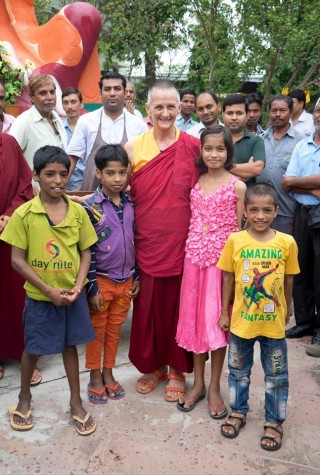
Ven. Trisha Labdron served Root Institute for 14 years, Bodhgaya, India. Photo courtesy of Root Institute.
Later that evening, the Sangha and lay community met again for protector prayers and pujas and dedicated them for the long, stable life of His Holiness. May we always be guided by His Holiness and receive teachings, blessings and initiations from him so that we too may become quickly enlightened for the benefit of all sentient beings.
In late June, the staff and volunteers of Root Institute expressed their deep gratitude and appreciation to Ven. Trisha Labdron who dedicated 14 years of selfless service to Root Institute at a farewell tea party. She initiated many projects including the Tara Children’s Project, the only orphanage for HIV-affected children in the state of Bihar. These projects have greatly benefited the local and regional communities.
On June 15 we welcomed our new director, Ven. Tenzin Paldron. Ven. Paldron worked alongside Ven. Trisha for three months before taking over her position. We look forward to the continuing success and growth of Root Institute and all of its projects.
Mandala brings you news of Lama Zopa Rinpoche and of activities, teachings and events from over 160 FPMT centers, projects and services around the globe. If you like what you read on Mandala, consider becoming a Friend of FPMT, which supports our work.
- Tagged: his holiness 80th birthday, root institute
- 0
6
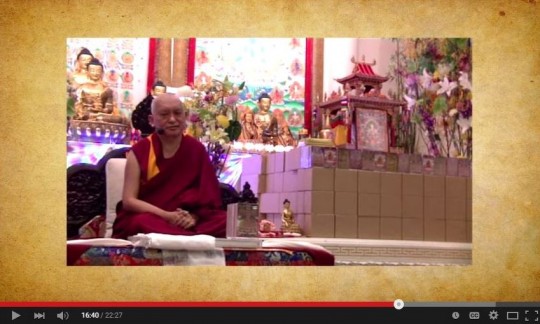
Screen shot of “The Heart of Our Happiness”
In 2014, Amitabha Buddhist Centre (ABC) in Singapore celebrated its 25th anniversary. To commemorate the anniversary, the center commissioned two videos, one of which was The Heart of Our Happiness, a short documentary reflecting on ABC’s growth and accomplishments over 25 years. The 22-minute video, thematically structured around Lama Zopa Rinpoche’s contributions to the center’s success, was made public in late April 2015 for all FPMT students to enjoy.
Watch the The Heart of Our Happiness on YouTube:
https://www.youtube.com/watch?v=XFGs59b4w9g
Mandala brings you news of Lama Zopa Rinpoche and of activities, teachings and events from over 160 FPMT centers, projects and services around the globe. If you like what you read on Mandala, consider becoming a Friend of FPMT, which supports our work.
- Tagged: amitabha buddhist centre, anniversary, video
- 0
3
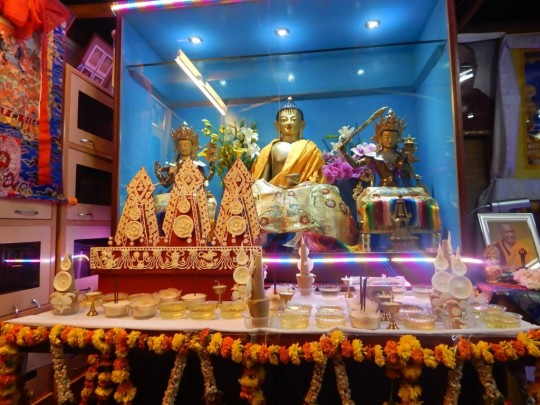
Tormas and offerings in preparation for statue consecration, Choe Khor Sum Ling, Bangalore, India, April 2015. Photo by Jeffrey Butts.
On April 25-27 FPMT center Choe Khor Sum Ling (CKSL) in Bangalore, India carried out the wishes of Lama Zopa Rinpoche by organizing the consecration of its gompa statues. Student Danyèle Grignon shared the news with Mandala:
The auspicious set of dates had been identified as April 25-27. Saffron water was poured in the offering bowls and garlands of flowers ornamented the altars. The monks from Gyume Monastery had collected scented substances, medicines, different types of grains and other items. Tormas were prepared in red and white colors.
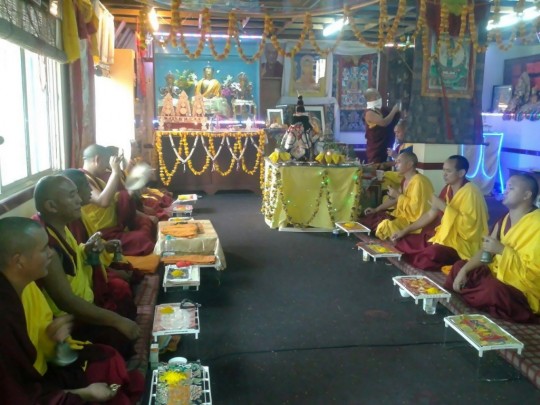
Fifteen monks from Gyume Monastery attended the consecration, Choe Khor Sum Ling, Bangalore, India, April 2015. Photo by Jeffrey Butts.
On April 25, the 15 monks of Gyume Monastery sat in two rows to open the ceremony with the relevant prayers and offerings. Lama Choepel, in charge to lead the rituals, uttered mantras while sprinkling holy water, rice and purifying herbs.
Lay people participated throughout the days of pujas, developing patience and deep listening. They prayed, read Dharma books, meditated and copied some verses of The Sutra of Golden Light.
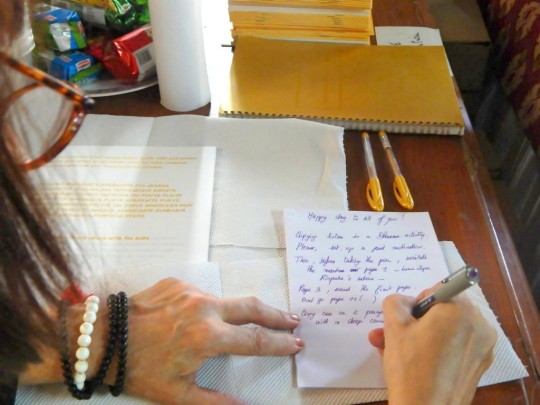
Lay students copied out The Sutra of Golden Light during the consecration and other events, Choe Khor Sum Ling, Bangalore, India, April 2015. Photo by Jeffrey Butts.
Later in the evening, Ven. Namjong from Sera Je Monastery gave the oral transmission of “Teaching on Ultimate Reality.”
Our collective prayers were dedicated to Nepal and a Medicine Buddha puja was offered for the earthquakes to stop and for the benefit of all the victims.
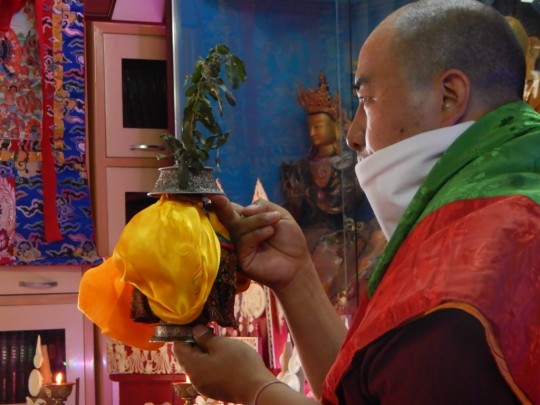
A monk with bumpa vase, Choe Khor Sum Ling, Bangalore, India, April 2015. Photo by Jeffrey Butts.
On April 26, students were offered a jenang, a tantric empowerment, and on April 27, two sur (aroma charity) ceremonies were conducted on the rooftop of the center.
Lama Zopa Rinpoche encouraged us to engage in these activities to collect extensive merits and pacify obstacles to CKSL Dharma projects, especially the expansion into a new location.
Mandala brings you news of Lama Zopa Rinpoche and of activities, teachings and events from over 160 FPMT centers, projects and services around the globe. If you like what you read on Mandala, consider becoming a Friend of FPMT, which supports our work.
- Tagged: choe khor sum ling
- 0
30
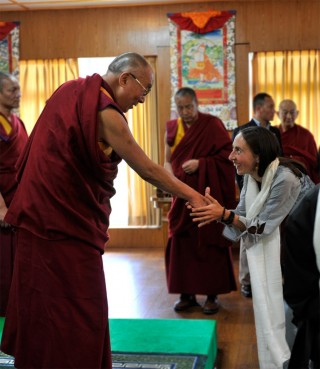
His Holiness the Dalai Lama and Franziska Oertle, 2014
In October 2015 the seventh Lotsawa Rinchen Zangpo Translator Programme (LRZTP7) will begin. LRZTP is FPMT’s only Tibetan-language interpretation program, located in Dharamsala, India. Students spend two years in Dharamsala acquiring the language skills necessary for interpretation and can spend another two years outside of Dharamsala receiving onsite training as an apprentice interpreter.
One of LRZTP7’s newest teachers is Swiss-born Franziska Oertle. After meeting His Holiness the Dalai Lama in 2006, Franziska moved to Bouddhnath, Nepal, where she lived with a Tibetan host family and studied Buddhist philosophy and Himalayan languages at Kathmandu University (Rangjung Yeshe Institute – RYI). After finishing her Bachelors degree in 2009, she worked as a Tibetan language instructor and interpreter trainer while completing her Masters degree in Tibetan grammar.
Since then, Franziska as been teaching colloquial Tibetan language on various levels and institutions in Nepal and India including: the Emory University Study Abroad semester; the RYI Intensive Summer Course; the School of International Training; and Sarah College.
Wishing to contribute to Tibetan language learners as well as the preservation of the endangered Tibetan language, Franziska is writing a colloquial Tibetan manual. Unlike other textbooks, it synthesizes traditional indigenous Tibetan grammar and contemporary language learning methods.
LRZTP7 director Yaron Bahir sat down with Franziska to talk to her about the studying and teaching of Tibetan:
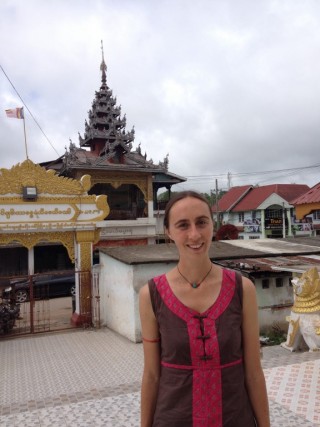
Franziska Oertle
What is the benefit of studying the Tibetan language?
Since language is inherently linked with culture, one can probably only gain a deep and thorough understanding of Tibetan people and the Dharma if one knows the Tibetan language. One of the major personal gains is being directly able to understand Tibetan lamas and rinpoches.
On a more global level, every Tibetan language student contributes to the preservation of an endangered language. And in the case of translators, they are the bridge between languages and cultures and are indispensable for the spreading of the Dharma.
What methods of teaching do you use to teach the Tibetan language?
The Tibetan language is very peculiar and its grammar extremely vast, profound, and beautiful. Therefore, I find it very important for students to understand the Tibetan language from within by studying the two major Tibetan grammar treatises, the Sum cu pa and rTags kyi ‘jug pa. At the same time, in order for the language to become alive we need to embrace contemporary (communicational) teaching methods and a large variety of different activities, supports, and materials, such as dialogues, stories, games, audio, electronic dictionaries, flash card programs on phones and iPads, etc.
Do you have any brief advice for anyone who wants to study Tibetan?
You just have to love it! When we love what we are doing, we learn more quickly and happily. And my second heart advice: immerse and connect yourself into the Tibetan-speaking world as much as you can. Ideally, if your life-conditions permit, live for some time in a Tibetan-speaking part of the world.
Registration for LRZTP7 is now open. Please visit the website for more information: www.lrztp.org
Mandala brings you news of Lama Zopa Rinpoche and of activities, teachings and events from nearly 160 FPMT centers, projects and services around the globe. If you like what you read on Mandala, consider becoming a Friend of FPMT, which supports our work.
27
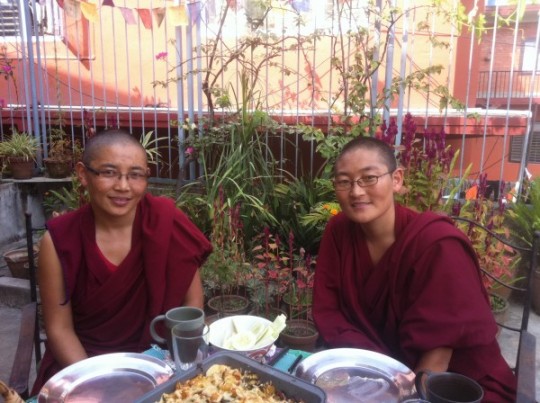
Vens. Jangchub Gyalmo and Namdrol Phuntsok, October 2012. Ven. Namdrol Phuntsok recently placed first for third-year nuns during the May 2015 exam round.
Tibetan Nuns Project recently announced on its website the results of the third round of geshe exams for women (sometimes referred to as “geshe-ma exams”) that took place May 1-12, 2015 at Jangchub Choeling Nunnery in southern India. Two of the 37 nuns who participated in the exams this year came from Kopan Nunnery. Ven. Namdrol Phuntsok, from Kopan, earned the first position within the third-year group (comprised of 20 women). The exams include debate and written papers.
The Geshe-ma degree, equivalent to the Geshe degree for men, is the culmination of scholastic learning for Gelug nuns. Although women have been traditionally excluded from participation in geshe studies, support from Gelug religious and political authorities, such as His Holiness the Dalai Lama, allowed the geshe-ma exams to begin in 2012 under the supervision of the Geshema Examination Board, made up of representatives from the Tibetan government, the Tibetan Nuns Project, the Institute of Buddhist Dialectics and six concerned nunneries located in India and Nepal.
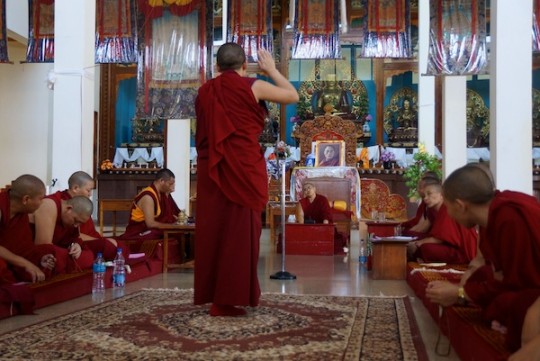
The geshe-ma examinations include debate, Jangchub Choeling Nunnery, Mundgod, India, May 2015. Photo via Tibetan Nuns Project (tnp.org).
Ven. Namdrol Phuntsok, along with classmate Ven. Jangchub Gyalmo, shared in the interview “A Straight and Steady Motivation” (Mandala January-March 2013) how important it will be for the first women to get the Geshe degree:
“It is not entirely sure that we will earn our Geshe degrees. But if we get the degree, we will be in a role in which we take on some responsibilities. We will offer beneficial service like teaching or sharing the essence of the Buddhadharma and encouraging its practice here in Nepal or in other countries. Or if we stay in the nunnery, we will teach other young nuns what we know. …”
The first Geshe degrees for Tibetan nuns will be awarded after the fourth set of exams in 2016.
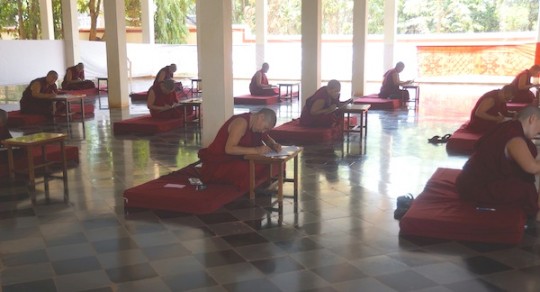
Nuns taking written exam for Geshe degree, Jangchub Choeling Nunnery, Mundgod, India, May 2015. Photo via Tibetan Nuns Project (tnp.org).
In April 2011, Geshe Kelsang Wangmo made history by becoming the first female geshe.
You can support FPMT’s projects for nuns and monks through the Supporting Ordained Sangha Fund.
Mandala brings you news of Lama Zopa Rinpoche and of activities, teachings and events from nearly 160 FPMT centers, projects and services around the globe. If you like what you read on Mandala, consider becoming a Friend of FPMT, which supports our work.
- Tagged: geshe studies, khachoe ghakyil ling, ven. namdrol phuntsok, women
- 0
23

Some participants of the 8th annual Saka Dawa mani retreat held by Rinchen Jansem Ling Retreat Centre, Triang, Malaysaia, June 2015. Photo courtesy of Rinchen Jansem Ling Retreat Centre.
Rinchen Jangsem Ling Retreat Centre (RJL) in Malaysia recently completed its 8th annual one-month mani retreat, a tradition for the center during Saka Dawa (mid-May to mid-June) encouraged by Lama Zopa Rinpoche. Two hundred forty-six participants from four countries accumulated 22,592,107 mani recitations, the mantra OM MANI PADME HUM.
“This retreat is designed to make it easy for people from around the world to participate and create merits in this auspicious month at home,” said Ven. Sonam, who coordinated the event. “The commitment for doing the retreat is to recite at least one mala (108 manis) every day and complete the recitation without any interruption until the last day of the retreat. Participants who have completed at least 11,000 mantras have their names sent to Kyabje Zopa Rinpoche for blessings. In addition, those who have completed one or more sets of 110,000 mani mantras can designate a name to be engraved on a plaque next to a beautiful Tara statue for each set.”
During the month, RJL invites all participants to Sunday practices at the gompa for the opportunity to generate merit together as a community. Additionally, the center organizes a nyung nä, an intensive two-day Chenrezig retreat, for students.
“This year we would like to specially dedicate our mani retreat for the long life of His Holiness the Dalai Lama who is celebrating his 80th birthday in July and to the victims of the Nepalese earthquake,” Ven. Sonam said.
Annual 100 million mani retreats are one of Lama Zopa Rinpoche’s Vast Visions.
Mandala brings you news of Lama Zopa Rinpoche and of activities, teachings and events from nearly 160 FPMT centers, projects and services around the globe. If you like what you read on Mandala, consider becoming a Friend of FPMT, which supports our work.
- Tagged: rinchen jangsem ling
- 0
23

“Compassion is the real money” bamboo t-shirt by Anye. Design by Cajvanean Alexandru | Photo by Greer Tilford Model | Model: Michaella Shannon
Canadian FPMT student Ryan Wright recently launched Anye, a non-profit organization dedicated to having a direct positive social impact, particularly on young people. By offering “suffering-free” and fashionable graphic t-shirts and tank tops, Anye splits 100% of its profits between Tara Children’s Project, an orphanage run by FPMT center Root Institute for HIV-affected children and youth in Bodhgaya, India, and the Pundarika Humanitarian Foundation, a non-FPMT organization which provides education programs for women and girls from rural Nepal and Tibet. Although Anye’s current priority is its “heartcore” fashion line, the organization regularly does Lama Zopa Rinpoche-inspired animal liberations and has plans to start implementing meditation programs in Canadian high schools. Mandala asked Ryan a few questions about Anye’s evolution and future:
How did you come up with Anye? Is it just another fashion company?
The idea for Anye was conceived in 2011, while I was in Bodhgaya, India. I spent four months there that year in order to complete the preliminary practice of prostrations at Mahabodhi Temple. Notably, His Holiness the Dalai Lama came to Bodhgaya that year to give the Kalachakra, so it was a very inspiring time!
During those four months I was just so deeply inspired, both by the practice and by Lama Zopa Rinpoche and everything he does to benefit others! Some of that started to rub off on me I think. As the practice progressed, I really wanted nothing more than to commit my life to sustained, dedicated meditation practice and to being of service to others any way that I could. The idea for Anye just popped into my mind one day while on a break from practicing. It really began as a very simple notion: to promote altruism in the world.
Growing up, I had always appreciated “cool” and unique t-shirts. However, sadly, many t-shirt companies often fall short when it comes to production, not choosing environmentally friendly or “suffering-free” clothing to put their designs on. For this reason, our team decided that we would simply create our own distinct t-shirt line, shirts that we would be excited to walk around in and that are created in a socially and environmentally responsible way – Dharma inspired clothing, what we call “heartcore clothing.”
This also provided a unique opportunity to promote virtue, both through the designs (i.e., the messages on each shirt) and by donating profits to amazing, volunteer-run partner charities like the Tara Children’s Project.
What makes Anye’s clothes “suffering-free”?
I’ve read in several places that the textile industry is one of the largest contributors to global warming. Accordingly, all of our clothes are earth friendly (organic cotton, bamboo, etc.). As well, our clothing line is sweatshop-free and supports education programs for children in Asia.
Our clothing line was created with the sole purpose of being able to support children and youth from rural areas of India, Nepal, and Tibet, helping cover the costs of their schooling. By buying one of our garments, at the very least, you are sending a child to school for two weeks! Our customers actually get to pick the price they pay for our apparel, which determines how much we are then able to pass on to the education programs (e.g., sending a child to school for either two weeks, one month, or two months). Our model can be summed up as follows: make a donation, send a child to school, and receive any piece of Anye apparel as reward for your act of kindness and generosity.
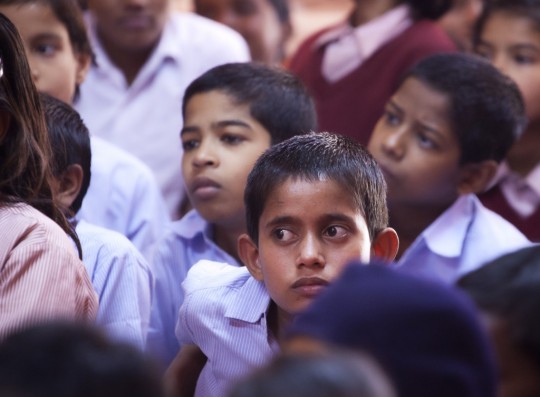
Some of the children supported by Tara Children’s Project, Bodhgaya, India, March 2014. Photo by Andy Melnic.
Why Tara Children’s Project?
Tara Children’s Project is connected to the FPMT; it is an orphanage for children affected by HIV. Having HIV in a place like India, where there is still a lot of stigma and discrimination, can be pretty tough. India is so populated and if you have ever been then you know that people can often get left by the wayside there, especially if they are subject to poverty, lack familial support, or have a disability or chronic illness. Being an orphan with HIV is a pretty challenging spot to be in anywhere in the world, but especially in India!
Fortunately, antiretroviral medication is free there, which is amazing, but getting an education is really the most important chance the Tara Children’s Project children have to overcome the stigma they face. And so that’s where we are trying to help. We spoke with Andy Melnic, who is the project coordinator and who let us know this is where they could use some support.
At present, there are 22 children at Tara Children’s Project that we are working to cover the education costs for through Anye. Ideally, we would like to be able to send US$550 per month to them, which would cover the tuition for all of their children.
Keeping the focus on education, we also added the Pundarika Humanitarian Foundation as a second project we support because of the pioneering education programs they provide for young girls from Nepal and Tibet, girls who wouldn’t otherwise get a chance to go to school.
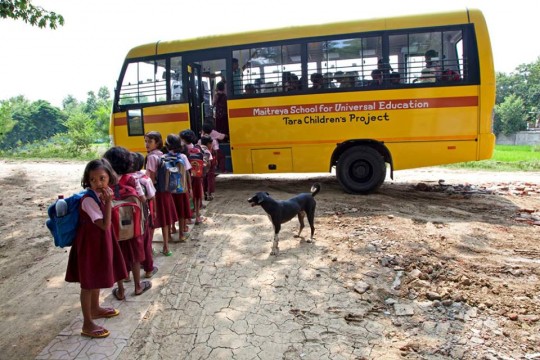
Children head to school on the bus that serves Tara Children’s Project and the Maitreya School. Photo courtesy of Anye.
Tell us about the animal liberations.
Our goal is to be of as much benefit as possible! Animal liberation is one of my favorite practices to do in Asia and so, after returning to the West, we just formalized that practice as part of what we do here too.
Importantly, our animal liberation efforts are peaceful, meaning we purchase the animals. We follow the advice of both Lama Zopa Rinpoche and Chatrul Rinpoche during our liberations. This involves a lot of prayers, prayers for the animals and their long lives, prayers for the upliftment of all life on this planet, prayers for the environment, etc. We also work hard to never buy from the same store/seller more than once so as not to create more of a market for the buying and selling of animals and insects and we always return the animals back to the same eco-system they came from. As an example, if liberating fish or lobsters we make sure to put them back in the ocean or lake they came out of. This is really important!

“Love to love” organic tank top by Anye.
Design by Giulio Rossi | Photo by Greer Tilford Model | Model: Rylan Schultz
How has the launch gone so far? What are the next steps?
Everything has been great so far. Many people seem to like what we are trying to do with the clothes. Starting a new brand can be a bit slow going at first, but we have lots of great design ideas and are excited about bringing these to life in the near future. Both volunteer-run organizations are doing such amazing work and our hope is simply to inspire others to get involved and help them out any way that they are able. This is the main focus of our clothing line. My hope is that Anye can eventually become a self-sustaining operation that continues to provide financial support to the children from Tara Children’s Project and the Pundarika Humanitarian Foundation year round.
Benefiting animals in any way possible is a priority for FPMT and one of Lama Zopa Rinpoche’s Vast Visions for the organization. Both the Lama Zopa Rinpoche Bodhichitta Fund and the Animal Liberation Fund support animal liberation activities around the world.
Mandala brings you news of Lama Zopa Rinpoche and of activities, teachings and events from nearly 160 FPMT centers, projects and services around the globe. If you like what you read on Mandala, consider becoming a Friend of FPMT, which supports our work.
- Tagged: anya, income generation, ryan wright
- 1
20
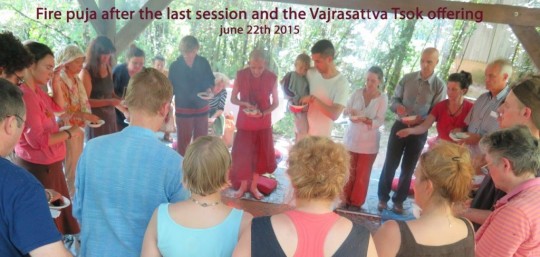
Fire puja after the 108th nyung nä session of Institut Vajra Yogini’s fourth annual nyung nä retreat, Marzens, France, June 22, 2015. Photo courtesy of Institut Vajra Yogini.
Each year Lama Zopa Rinpoche, through the Practice and Retreat Fund, personally sponsors up to 10 people willing to do 100 nyung näs – an intensive and demanding two-day Chenrezig retreat – at Institut Vajra Yogini (IVY) in France. Institut Vajra Yogini started a yearly retreat to help make one of Rinpoche’s Vast Visions come true – that some practitioners might complete 1,000 nyung näs during their lifetimes. François Lecointre, center director, shares news about the completion of IVY’s fourth annual nyung nä retreat.
Six people tried to do all 108 nyung näs, but only Ven. Charles managed to do every single session. The other five people all had to miss a few for various reasons (sickness, lung, family problems, etc.), but the five of them accumulated a total of 450 nyung näs.
These five “Dharma heroes” are:
- Norman Gröning, a young lay Dutch man who had already done 100 last year. He did 96 this year at IVY, but had done 43 alone just a few months before.
- Toine Janssen, a long-time Dutch lay resident at Nalanda Monastery, did 102.
- Nathalie Lecrux, a quite new but very enthusiastic French student, did 106.
- Rowena Fish, a British woman, did 64.
- Thomas Geldern, a German man and Rowena’s partner, did 82.
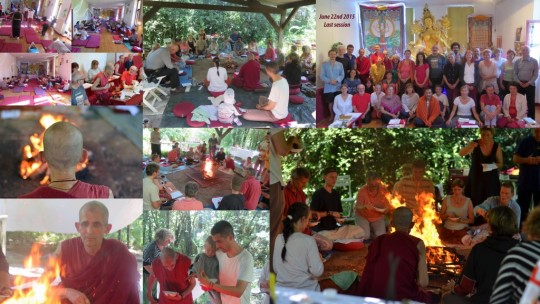
Collage of last nyung nä session, Marzens, France, June 22, 2015. Photo courtesy of Institut Vajra Yogini.
Sixteen other people completed eight nyung näs or more: Pierre Cristiani (40), Christophe Adell (40), Patrice Castaing (15), Philippe Sudre (13), Annie Boyer (13), Antony Darreux (11), Dani Villalta (10), Franz Millier (10), Christine Motta (10), Corinne Pian (10), Marie Vaysse (10), Conor Downes (9), Laurette Laboureur (9), Didier Hosotte (9), Yann Dulac (8) and Sharon Overbey (8).
101 other people did one to seven nyung näs.
If we add up everybody, there were 123 different participants from mid-November 2014 to the end of June 2015 and 1,028 individual nyung näs have been accumulated. On average, we have had between 7 to 15 people participating in each single session.
We want to thank Rinpoche for giving us this wonderful opportunity to practice and to organize and to serve such a wonderful and beneficial retreat. May Rinpoche bless us so that we’ll be able to fulfill his wishes. We want Rinpoche to know that we particularly wish to dedicate all the merits that have been generated to his long life, good health and the immediate fulfillment of all his holy wishes.
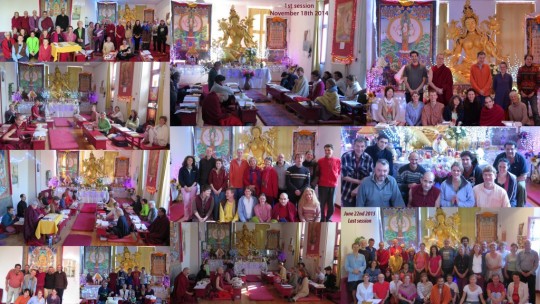
Collage of various nyung nä sessions, Marzens, France, November 2014 – June 2015. Photo courtesy of Institut Vajra Yogini.
A fifth round will be organized from mid-November 2015 to the end of June 2016. Please contact Institut Vajra Yogini if you are interested in participating in any way, to simply learn more or to offer to sponsor a retreatant.
Mandala brings you news of Lama Zopa Rinpoche and of activities, teachings and events from nearly 160 FPMT centers, projects and services around the globe. If you like what you read on Mandala, consider becoming a Friend of FPMT, which supports our work.
- Tagged: institut vajra yogini, nyung nä, vast visions
- 0
18
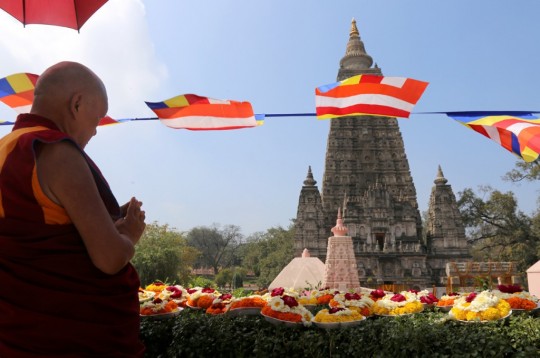
Lama Zopa Rinpoche making offerings to the Mahabodhi Stupa, Bodhgaya, India, February 2015. Photo by Ven. Thubten Kunsang.
Ven. Tenzin Legtsok, an American monk in his 12th-year of geshe studies at Sera Monastery in India, discusses the power of stupas and other sacred objects in Mandala‘s newest online feature: “How Do Holy Objects Work?” Ven. Legtsok begins with an explanation of a common teaching story about a fly benefiting greatly by unintentionally circumambulating a stupa.
“The story, told in Liberation in the Palm of Your Hand, is about an old man named Shrijata who wanted to leave his home and take ordination. Venerable Shariputra refused to give Shrijata novice vows, explaining that he didn’t have the roots of virtue to be able to keep ordination. Shrijata was utterly disappointed. Shakyamuni Buddha saw the situation through his clairvoyance, appeared to Shrijata and told him that he does have the roots of virtue to take ordination, but that this virtue is so subtle that Shariputra could not see it. This virtue, the Buddha said, was created in Shrijata’s past life when as a fly – following a cartload of dung – he unknowingly circumambulated a stupa.
“… But a question remains: how does an inanimate object – no matter how sacred – affect sentient beings regardless of their motivation? This is not so easy of a question to answer. If you’re in doubt that the Buddha taught this, the idea is reiterated in the King of Concentrations Sutra, where it says that even looking upon a drawing of a stupa with a mind of anger creates the cause to see millions of buddhas in the future. Similar statements are made in other sutras – such as the Sutra of Golden Light or the Sanghata Sutra – about how hearing merely a few lines from these sutras purifies negative karma collected over eons and helps a practitioner accumulate inconceivable amounts of merit. Lama Zopa Rinpoche has explained that such effects are due to the power of prayer. ‘It’s like mantra,’ Lama Zopa Rinpoche says. ‘A mantra has power because a buddha blesses it to have power. A mantra is powerful because a buddha makes it powerful. This [ability], the power of prayer, is one of a buddha’s 10 powers.'” Read more …
In case you missed last month’s online feature, “A Many-Splendored Thing: Anne Carolyn Klein on the Transmission of Tibetan Buddhism,” you can read it now. If you like Mandala’s online features, consider becoming a Friend of FPMT, which supports our work as well as the education programs of FPMT.
- Tagged: holy objects, stupas, ven. tenzin legtsok
- 0
- Home
- News/Media
- Study & Practice
- About FPMT Education Services
- Latest News
- Programs
- New to Buddhism?
- Buddhist Mind Science: Activating Your Potential
- Heart Advice for Death and Dying
- Discovering Buddhism
- Living in the Path
- Exploring Buddhism
- FPMT Basic Program
- FPMT Masters Program
- FPMT In-Depth Meditation Training
- Maitripa College
- Lotsawa Rinchen Zangpo Translator Program
- Universal Education for Compassion & Wisdom
- Online Learning Center
- Prayers & Practice Materials
- Overview of Prayers & Practices
- Full Catalogue of Prayers & Practice Materials
- Explore Popular Topics
- Benefiting Animals
- Chenrezig Resources
- Death & Dying Resources
- Lama Chopa (Guru Puja)
- Lama Zopa Rinpoche: Compendium of Precious Instructions
- Lama Zopa Rinpoche: Life Practice Advice
- Lama Zopa Rinpoche Practice Series
- Lamrim Resources
- Mantras
- Prayer Book Updates
- Purification Practices
- Sutras
- Thought Transformation (Lojong)
- Audio Materials
- Dharma Dates – Tibetan Calendar
- Translation Services
- Publishing Services
- Teachings and Advice
- Find Teachings and Advice
- Lama Zopa Rinpoche Advice Page
- Lama Zopa Rinpoche: Compendium of Precious Instructions
- Lama Zopa Rinpoche Video Teachings
- ༧སྐྱབས་རྗེ་བཟོད་པ་རིན་པོ་ཆེ་མཆོག་ནས་སྩལ་བའི་བཀའ་སློབ་བརྙན་འཕྲིན།
- Podcasts
- Lama Yeshe Wisdom Archive
- Buddhism FAQ
- Dharma for Young People
- Resources on Holy Objects
- Ways to Offer Support
- Centers
- Affiliates Area
- Teachers
- Projects
- Charitable Projects
- Make a Donation
- Applying for Grants
- News about Projects
- Other Projects within FPMT
- Support International Office
- Projects Photo Galleries
- Give Where Most Needed
- FPMT
- Shop
Subscribe to FPMT News
Translate*
*powered by Google TranslateTranslation of pages on fpmt.org is performed by Google Translate, a third party service which FPMT has no control over. The service provides automated computer translations that are only an approximation of the websites' original content. The translations should not be considered exact and only used as a rough guide.If you don’t know your own psychology, you might ignore what’s going on in your mind until it breaks down and you go completely crazy.







